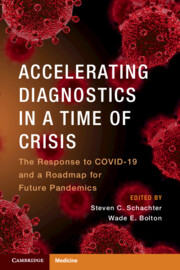 Accelerating Diagnostics in a Time of Crisis
Accelerating Diagnostics in a Time of Crisis Published online by Cambridge University Press: 06 January 2024
In the face of a rapidly emerging pandemic, there needs to be a concerted and organized response so that the pandemic can be stopped or slowed and patients can be accurately diagnosed and treated. As we learned with severe acute respiratory syndrome coronavirus 2 (SARS-CoV-2), there was no prescribed roadmap to follow, leaving scientists and clinicians to plan and respond in real time. Although the efforts were heroic in nature, some decisions (if they could be made again) would have been different. In this chapter, we address the lessons learned from the individuals who were on the battlefield in their area of expertise as they chartered their own path. We capture and record the activities that took place so that, going forward, there will be an extensive pandemic response roadmap indicating the activities of this pandemic (including their chronology and duration) for future generations to use as a guiding document to build upon.
To save this book to your Kindle, first ensure [email protected] is added to your Approved Personal Document E-mail List under your Personal Document Settings on the Manage Your Content and Devices page of your Amazon account. Then enter the ‘name’ part of your Kindle email address below. Find out more about saving to your Kindle.
Note you can select to save to either the @free.kindle.com or @kindle.com variations. ‘@free.kindle.com’ emails are free but can only be saved to your device when it is connected to wi-fi. ‘@kindle.com’ emails can be delivered even when you are not connected to wi-fi, but note that service fees apply.
Find out more about the Kindle Personal Document Service.
To save content items to your account, please confirm that you agree to abide by our usage policies. If this is the first time you use this feature, you will be asked to authorise Cambridge Core to connect with your account. Find out more about saving content to Dropbox.
To save content items to your account, please confirm that you agree to abide by our usage policies. If this is the first time you use this feature, you will be asked to authorise Cambridge Core to connect with your account. Find out more about saving content to Google Drive.